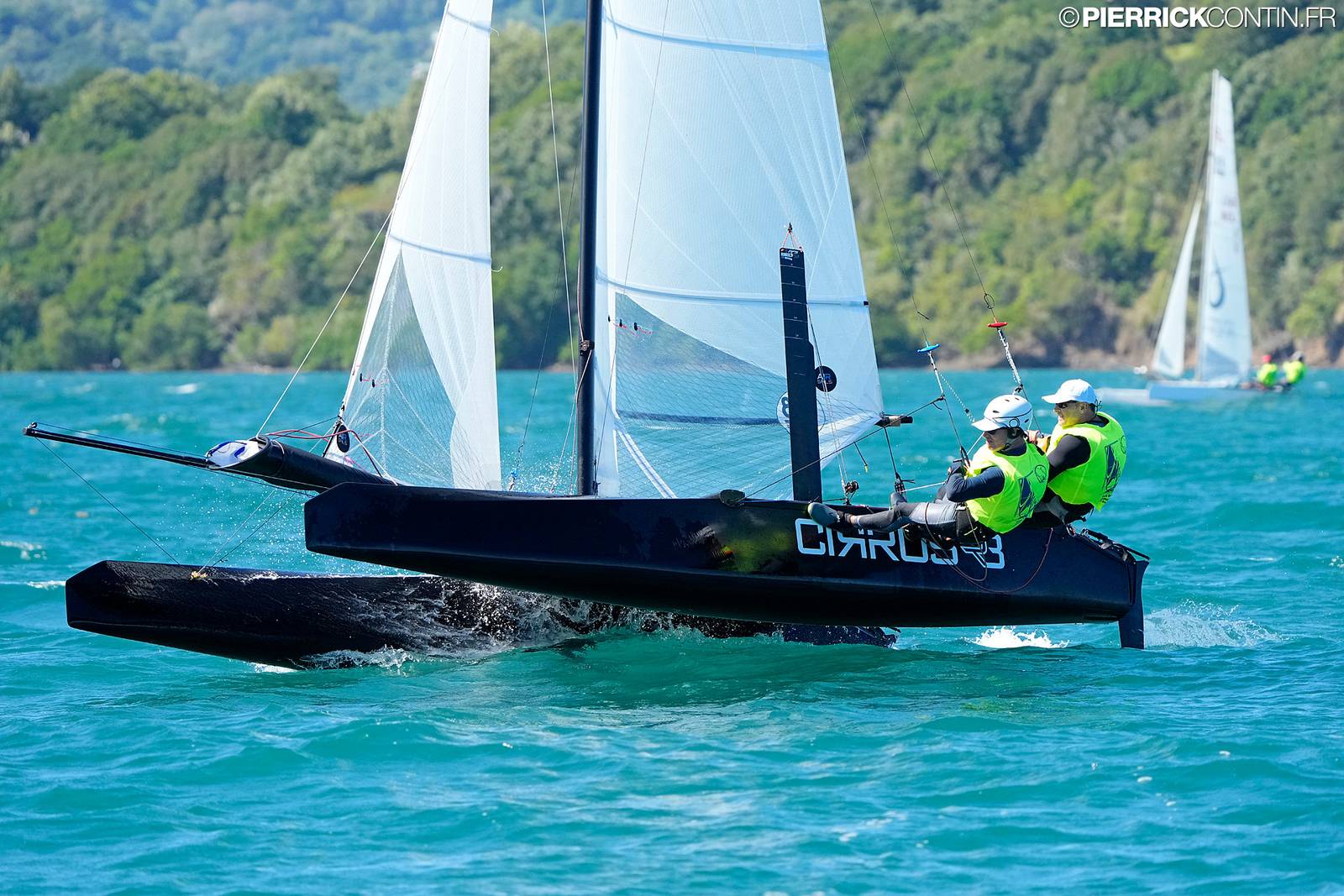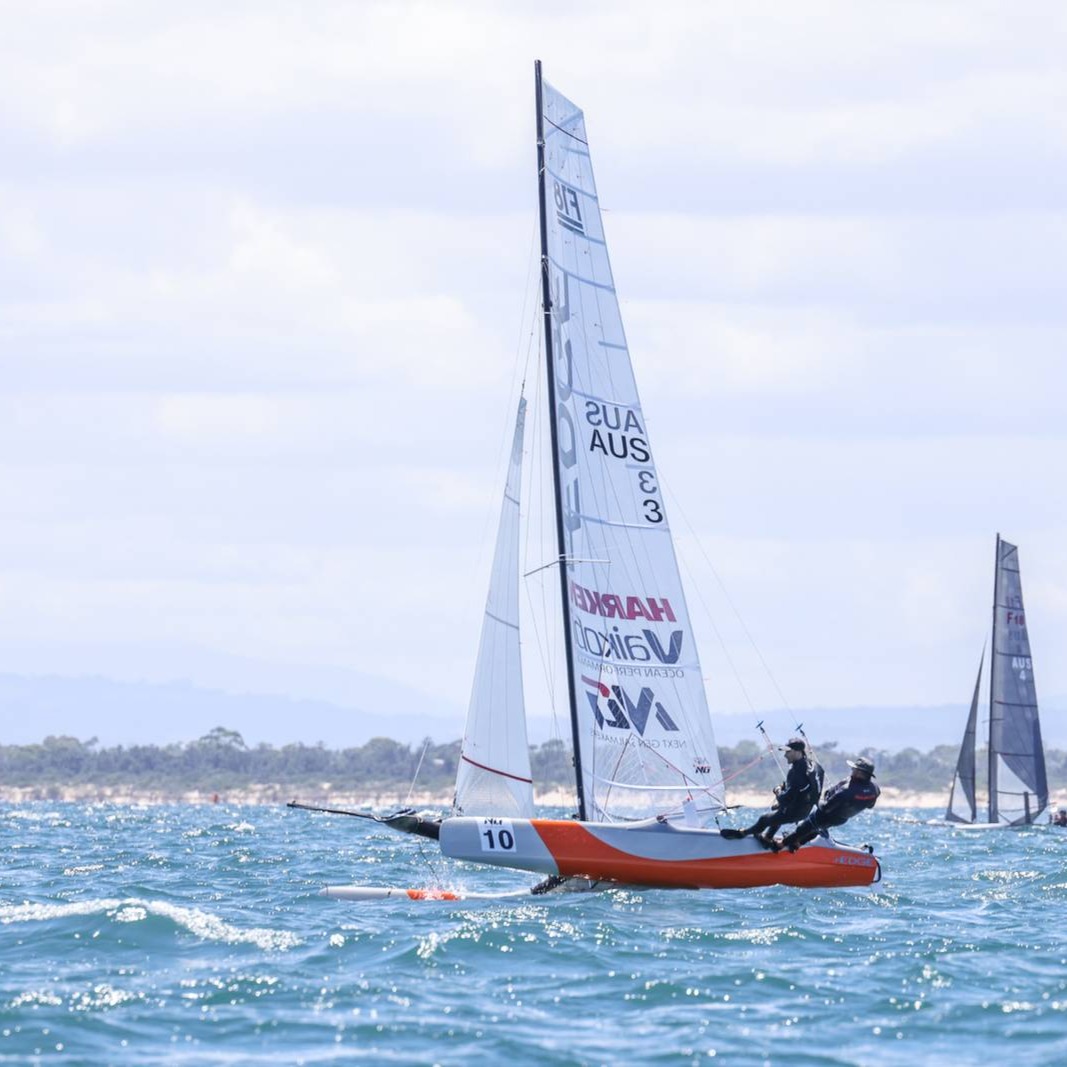Foiling Proa by Rob Denney
This looks good. Although I still don’t buy the versatility on maneuvers and handling, Rob Denney from Harry Proa keeps refining his concepts. Today he sent these renders & text. Above concept was made for the Volvo inshore racer. (More news on that selection coming soon)
Below excerpt from Rob’s full presentation ( harryproa.com/wp-content/uploads/2017/10/volvoproa.pdf) and how he reached this new concept.
———-
SPECIFICATIONS
Weight: 480 kgs
Sail Area: 66 sq m
Length: 15m
Mast height: 20m above water
Beam: 8.4m
Frontal Area: 8.8 sq m at 25° apparent while foiling, excluding rig and rudders
Wetted Surface: 12 sq m when floating including hulls, foils, rudders
Righting Moment: 7,240 kgm when flying
Draft rudders up: 0.2m
Draft rudders down: 1.75m
Shipping: 3 shipping containers for 8 boats
Cost: 150,000€
GENERAL DESCRIPTION
The numbers refer to items in the following drawing, page 3.
1) The triscarph configuration reduces weight, cost, wetted surface and drag.
2) Rudders at 30% and 70% of the length provide leeway resistance and faster steering than stern
mounted rudders.
3) Foils plug into the bottom of the rudder to enable changing foils afloat and simplify repairs.
Foil lift is controlled by wands linked to the foils.
4) The foil under the windward hull automatically rotates to follow the direction the boat moves in.
5) The crew hull is always to windward and all sail controls lead to it. Once the sail is up, the crew
do not move from the windward hull except in wind below 6 knots.
6) The single main sail is large enough that no extra sails are required. The 20m mast puts sail
area above the turbulence and wind shadows in sheltered venues and ensures hull flying in 6
knots of breeze.
7) The two piece mast slots together and is raised and lowered sideways (canted) using the sheet
winch.
8) The wishbone boom extends in front of the mast where it attaches to the forestay. Leech tension
tightens the forestay, keeping the mast straight. A lever on the diamonds provides 30:1 purchase
from the cockpit.
9) Washboard for easy guest access and padded stool for him/her to sit on.
10) Trampolines in carbon rod frames attached to the beams with quick release buckles.
11) Removable soft ends to limit impact damage.
12) Remote controlled camera to view the sails, foils, crew and other boats without risk of damage
from crew, sheets or sails
——-
Rob Denney – Bucket List update.
After half a dozen sails with a 40% mainsail, it got too cold to play so BL sat on it’s anchor for a couple of months while I decided what to do next. The issues were:
i) Although there was some interest in chartering racing multis, there was none in either paying for 4 of them or running the business.
ii) The quality of the build is poor as a result of limited build time during my trips to Adelaide. In particular the leeward hull repair of a screw up with the mould dimensions and one of the beams which has the vacbag and resin absorber stuck inside it.
iii) A 12m x 8m boat drawing 100mm without (and with) a motor is a handful to maneuver solo in a breeze.
iv) Anchoring in a busy waterway is fraught. Every time the breeze was up, it was surrounded by kite boarders, most of whom were beginners. A powerboat cut the anchor warp one night, the boat was stopped by a couple of fishermen at 1 am just before it reached the open sea, next stop Chile. A fortnight later, it was impounded by the water police for being anchored in the same spot for over a week. The canal berth I had arranged for bad weather fell through.
v) I am not going to get time to sail it to regattas.
At the same time, we started brainstorming a design for the Volvo Ocean Race inshore foiler. This produced 3 new ideas. Foils, an out of hull rig and a triscarph lee hull. Followed by the realisation that an automatically self righting proa was feasible.
The upshot of all this is that BL is being turned into a trailerable foiler so we can check these ideas out.
The beams will be reduced to 6m (ease of trailering, shorter load on the trailer, able to fit in my canal berth, chop off the dodgy bit). Righting moment is reduced, but not by much as the rig will be 2m to ww of the leeward hull, supported by stays to the ends of the beams, the same as the Volvo proa. It will not have the diamonds or the extended boom as the current mast does not require them. The rig is easier to raise and lower and allows the easiest means of altering the rake/sail balance. This also is not required with the current rig, but would be if the sail area was maximised.
The lee hull will be chopped up into 2 x 3.5m hulls, joined by a 6m x 150mm dia carbon tube. The ww hull chopped down to half the height and a cockpit added. The beam clearance is reduced, but once foiling, will be higher than before.
The rudders and foils will be mounted on the hull sides so they can kick up.
The end result will be a weight saving of about 40% (500 kgs to 300 kgs), with another 50 to come when the beams and rig are optimized, less than half the windage and no component longer than 6m or heavier than 40 kgs. The loa (12m) stays the same, the sail area on the 3 piece, 16m (1.5m of which is “bury”) telescoping mast drops to about 45sq m.
Once we know all this works, a range of boats will be available for home or pro builders.
As always, I expect to be sailing by Xmas. Photos will be on the blog and facebook. The “Volvo Proa” presentation available here harryproa.com/wp-content/uploads/2017/10/volvoproa.pdf

































I just heard that my great sailing friend and former CEO of Hobiecat Europe has passed. May The endless oceans…
...Report was sent by an F18 Sailor, if you want Hobies reported send your own, we'll publish as usual. Cheers.
Looks like in your report the Hobies are not really present. Suggest to rewrite the article.
Thanks for the great report Wik. Great battle.
If I correctly read the results the overall winner this year is a Hobie16